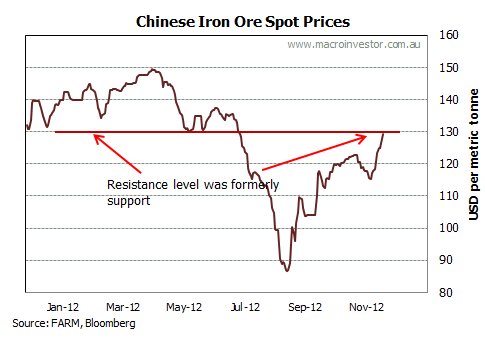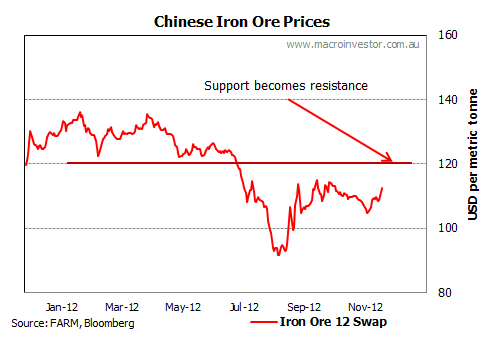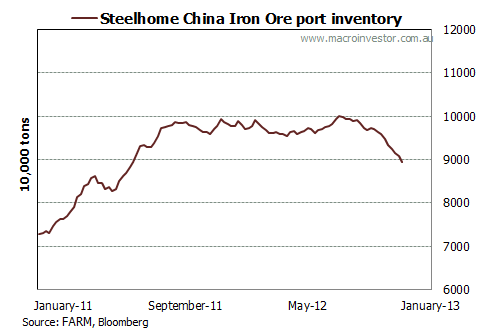Hello dear reader and welcome back to us both!
And so, to the topic at hand, the miracle commodity and its ripping rally. Here’s how I finished 2012:
So, is it sustainable? My guess is it’s a bull trap but I have no idea. As I wrote last week after the breakout, when a market begins twirling towards freedom, who knows where it stops? To give us some notion, here is the iron ore price chart with major resistance points:
That is, it is right on it. If it goes through, there is every chance that this move blasts higher still. How high? Here is the 12 month swap resistance level:
Swap will have to move higher as well and its resistance point is $120. I can’t see the spot move getting through $140 unless some new good news about Chinese urbanisation is forthcoming. But it could run on. As I’ve been pointing to for a while, Chinese port stocks have been falling steadily:
I’ve argued that this looks like a structural reduction in stockpiling as demand shunts lower for good. But if the Chinese government does announce broad new measures for more investment then this could reverse and the mother of all restocks take hold. A kind of physical short squeeze. Ore could do anything in that environment.
So, right about the context, wrong about the guess. It’s history now that ore blasted higher, and without any new Chinese announcements. It was simply enough that Chinese authorities made a general commitment to making infrastructure investment an ongoing part of their planning (and perhaps the fiscal cliff was dodged).
Back to the present. Here is the price table for January 11th, 2013:
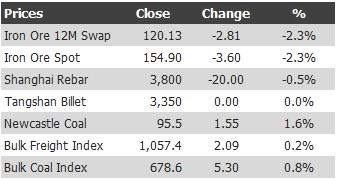
And the iron ore price chart:
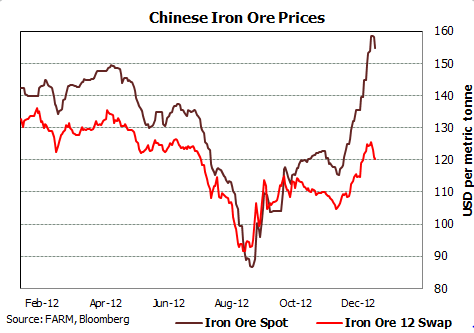
Wow! But as I said last year, iron ore can do this. When you have a commodity based so completely upon a single client and with very obvious hoarding and inventory cycles at work as a result, volatility is inevitable. That’s why we’re so spastic for failing to create a fiscal stabilisation mechanism like a resource rent tax attached to an sovereign wealth fund, but let’s not begin the year on that sour note!
So what now for the year ahead? The current market situation for the miracle commodity is very mixed. There is support for the notion that there is a shift towards more positive fundamentals with Chinese steel production picking up, unseasonably too, potentially meaning more strength ahead. China’s December steel PMI showed a surge across its metrics:

New highs in growth in output and new orders, incipient strength in new export orders, finished goods at reasonable levels and growth easing in inventories of raw materials. A potent mix!
There are also the figures for steel production from the World Steel Association for November which underline the unseasonable nature of this demand. The winter months tend to see softening steel production and ore demand because building is inhibited by the weather in northern China. But in November 2012 steel production in China was up almost 14% on the same month in 2011:
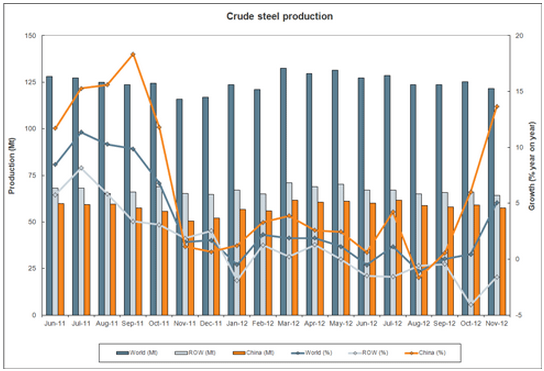
The same cycle is obvious in raw steel production figures from China. Note the lack of correction in the last months of 2012 compared with previous years:

This renewed vigour has resuscitated steel prices with rebar and billet both at post-bust highs even if the rally is less impressive than ore:

So, there is some fundamental basis to the move and the likelihood of ongoing steel production strength in the first half. But only some. Chinese steel prices remain well below their 2011 highs (rebar was above 5000 for instance). And what activity there is has failed to budge China’s bulk commodity shipping indexes:

On these fundamentals, then, I estimate that iron ore should still be trading in the $130 range. The swaps market agrees. 12 month swaps for iron ore have rallied but far less impressively than spot:
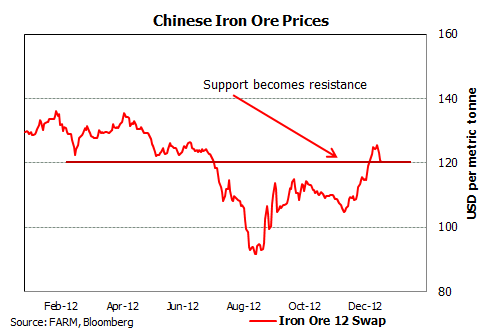
Although swaps did breach the $120 mark briefly they have retraced just as quickly, suggesting a bull trap. Adding to that contention – that the entire move in iron ore is a bull trap that will not last – are my swap spread charts, which have blown up sensible historical relationships. First, iron ore spot to 12 month swap which has hit unprecedented wides:
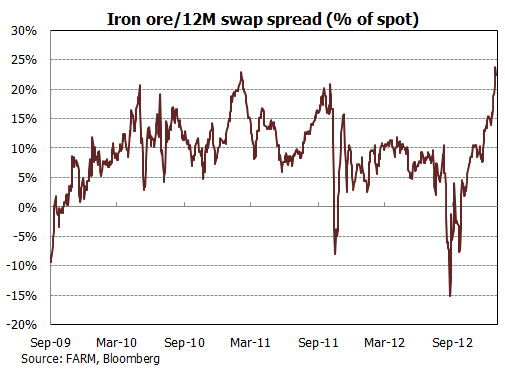
And, iron ore spot to rebar, which is only slightly less extraordinary:
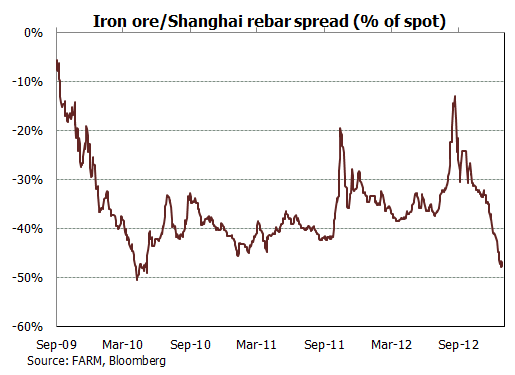
These two charts express the spreads as percentages of the underlying spot price. Thus they are designed to capture the spread relative to the overall price bracket of the market not simply the absolute spreads. Needless to say they are howling that the spot price has twirled into outer space.
This divergence from fundamentals can best be accounted for by the supposition that improving conditions for Chinese steel-makers and the hope that Chinese authorities will continue to build bridges to anywhere have combined to trigger an enormous second wave re-stocking of iron ore by Chinese steel mills. When it passes, as it may be now, prices and spreads will revert to historic relationships. Supporting this thesis is the fact that iron ore has twirled skywards solo, a la Yuri Gagaran. The price of iron ore’s twin commodity, coking coal, has barely budged from its 2011 hammering:
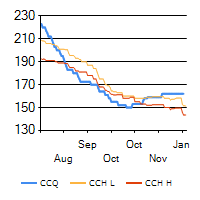
The temporary restocking thesis has swiftly become consensus in analyst land and the media for obvious reasons. But there is a hole in it. You would expect a Chinese restocking to show up in rebounding stockpiles, such as they are. As noted above, that’s not especially apparent in the steel PMI. Moreover, although only a rough guide, Chinese port inventories have stabilised at lower levels than last year but haven’t rebounded so far:
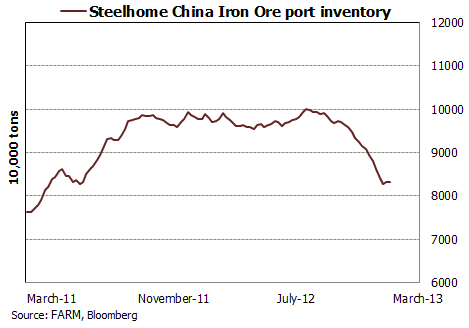
At this point then, stockpiles do not appear to have burgeoned overly but if Chinese mills, traders and hoarders get it in their heads that they need to rebuild reserves further then the iron ore price is not going to quickly revert (indeed it could go higher still). I argued last year that we’re probably seeing a structural shift to lower levels of stockpiles owing to a looser market in general and less hope of long term price appreciation. That theory may be about to be tested.
There is another reason on the supply side to help explain why the restock has been met with a rocketing price rather than being absorbed by increasing volumes. Regular readers will recall that I got quite excited late last year by the move by India’s judiciary to extend iron ore mining bans to Goa and Odisha states. These bans will most likely be resolved in favour of a resumption of ore exports, as they were in Karnataka in 2011 but that will take time. A year at least. In the mean time, Chinese imports from India collapsed late last year. Indeed, since India’s bureaucrats began their crackdown in 2010, almost the entire ramp of Australian iron ore export volumes can be seen simply as Australia hitting India for six. In the following chart of Chinese ore imports, Australia is white, India yellow and Brazil green:

And here are existing Indian sourced stockpiles in China:

Talk about India hitting its own wicket!
So, there is a significant offset here to the ongoing supply expansions in Australia, Brazil and Africa. India exported 100 million tonnes or iron ore in 2010 and 2011. Last year it was half. This year looks like it will be much lower again. If it all dries up, as it is right now, that’s Fortescue times two disappearing from available supply. With rebounding demand in China, supply is suddenly tight. Throw in the current flush of optimism that this year will deliver better growth in the US and Europe and you have an argument for the collective hoarders of iron ore to continue to run with.
It is not my base case that China will continue to rebuild its iron ore hoard to former highs (not least because I have no great hopes for European or US growth this year) but it can’t be discounted as a driver for iron ore strength deeper into 2013 than many now expect.
Mind you, the price will be swimming against the historical tide. The primary reason is the awesome new supply of iron ore – as much as 14% per annum for the next three years – that will inevitably undermine prices from current levels. Some will also argue that Chinese ore mining will resume mining but as regular readers will know, and the evidence to date supports, the suspensions were always grossly exaggerated, though there have been reports of winter shutdowns at the time writing:

The Chinese will continue to support local iron ore and its production will happily defy Western analyst predictions of a wipe out whatever the prevailing conditions.
More broadly, in the first half I expect Chinese GDP growth in the 9% range, then easing in the second half. This is not some new powerful virtuous cycle of Chinese private sector growth. The cycle is a publicly engineered rear guard action to prevent growth falling to hitherto unimaginable lows as China attempts its great rebalancing towards less steel-intensive consumption-led growth. Such is obvious when fixed asset investment is broken into its constituent parts:

Chinese authorities will keep their boot on real estate development and, despite recent better readings, manufacturing will struggle to maintain momentum as the global economy remains soft. Current popular rhetoric of a recovery in the US and Europe is overblown to my mind. In every year since the the GFC analysts and economists have misinterpreted a year-end global inventory bounce associated with Christmas as a new dawn for the global economy. This year will be no different. For the record, I expect a modest improvement with the US and Japan grinding higher, Europe dragging interminably and, by the last quarter of this year, China to be facing precisely the same questions asked in September last year: will its government save us with more stimulus?
Having said that, I think it obvious that iron ore is in for a better year than I envisaged a month or two ago. Those looking to short miners at this level haven’t much to lose but the payoff may be slower than consensus expects and there is a risk of higher prices if hoarding resumes in earnest. In my view, the price range for the first half will be better than many expect with oscillations between $130-$150 per tonne and India’s self-destruction ensuring solid volume expansions for local producers.
That’s materially higher than I expected late last year. The big miners are being bailed out nicely and you can expect sell-side analysts to upgrade profits in the weeks ahead. Juniors will also fare well in the first half. However, I would not be long for long and think it distinctly possible we will repeat last year’s price hammering in the second half.
Nonetheless, and contrary to most commentary on the matter, I also think that this price surge will have one lasting effect as it does translate into a modest increase in iron ore investment. The prospects for Gina Rinehart’s Roy Hill are looking decidedly brighter. Not that she’ll be thankful for the combined largess of Indian and Chinese socialists.
Tomorrow I will examine the implications for the Australian economy.

